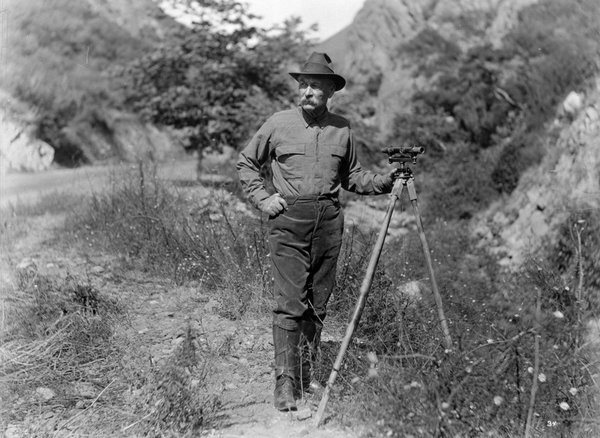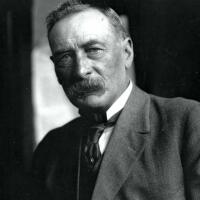When California's Water Wars Turned Violent

This story was originally published on PBS.org American Experience. "Flood in the Desert" premieres on PBS SoCal on Tuesday, May 3, 2022.
In September of 1904, William Mulholland, the man in charge of making sure Los Angeles had enough water, took a fateful camping trip. Together with one of the city's former mayors, Fred Eaton, Mullholland drove northeast about 250 miles to the Owens Valley, where the Sierra Nevada mountain range stood off to the west, its gleaming snowcaps melting into streams that fed the Owens River — or to Mulholland’s eyes, what could be an abundant water supply for the distant city. In the coming years, Owens Valley residents, just then unaware of the Angelenos in their midst, would grow to deeply resent both Mulholland and what he stood for: a thirsty metropolis whose ever-increasing water needs took primacy over their own livelihood.
Grand ambitions drove Mulholland's divination pilgrimage. In 1904, the population of Los Angeles had climbed to around 200,000, and already the city was running dry. Tapping the Owens River — which meant conveying it the more than 200 miles downstream, cutting across arid desert and tunneling through hardrock mountains — was a design and engineering feat, but Mulholland meant to make it happen. "Titanic Project to Give City a River," the Los Angeles Times lead headline proclaimed after the project was made public. And of the Inyo County property surrounding the river? "Eaton has made every option solid and secured all the land the city wanted."

Owens Valley residents had another read on Los Angeles' buying spree. Eaton had quietly begun purchasing water options adjoining the river without revealing to the farmers and ranchers what he and Mulholland intended to do with them. "Three months ago Eaton bought the holdings of the Rickey Cattle Company," the Times reported on July 29, 1905, "comprising about 50,000 acres of water-bearing land. It was then thought that Eaton was going into the stock-raising business here, but it has since been learned that he was securing options for Los Angeles city." (Soon after the Times made Eaton's scheme public, he was visiting one of the Valley's small towns with his son. A mob ran both Eatons out of town, but not before the prospector was promised unhappy consequences should he return.)
Nine years after his camping trip, Mulholland's audacious plan to create the world's largest aqueduct came to fruition. Water was plentiful; Los Angeles became the fastest-growing city in the country. By the early 1920s, the city's population had passed the one million mark. By then, though, years of drought had almost halved the aqueduct's flow. Los Angeles returned to the Owens Valley once more and accelerated its land purchases. Residents' water tables dropped. As farms produced less, the local economy faltered, investment dried up and banks refused to make loans. Schools closed.

Owens Valley's inhabitants came together in an attempt to negotiate with the city as a collective. Those attempts stalled. Worse still, Los Angeles went on the further offensive: In May 1924, the city filed a lawsuit against a lengthy list of individual farmers, claiming that they were the ones diverting water which belonged to the city.
Failed by the law, several dozen Owens Valley residents took it into their own hands. In the early hours of Sunday, May 21, 1924, they bombed a stretch of the Los Angeles aqueduct near the town of Lone Pine. The explosion marked the opening salvo in what came to be called California's "Little Civil War."

To the city, the war had turned uncivil. The bombers were terrorists. A furious Mulholland quickly dispatched detectives to uncover their plot. The local community, however, circled its wagons. "Every resident of the Owens Valley knows who did the dynamiting," one of the investigators remarked, "but no one will tell. Some of the most prominent and wealthy farmers and ranchers in the Owens Valley are involved." To those farmers, ranchers and many of their neighbors, the 40 men with their 500 pounds of dynamite outside Lone Pine had finally taken a definitive stand against ceaselessly encroaching metropolitan interests. For years their prosperity had been draining away along with the 300,000,000 gallons of water going to Los Angeles daily; enough was enough. A few days after the explosion, a local newspaper summed up local opinion on the controversy. "The defendants in this case, the water owners and users of this section, are the men who helped build the west," the Big Pine Herald declared.
A deep and dark undercurrent of irony flowed through current residents' outrage over their disappearing water rights.
In giving sole credit to the valley's current inhabitants for its development, the paper took a decidedly short view of history. When white settlers first arrived in the Owens Valley in the 1850s and 1860s, they found native Paiute societies whose sophisticated irrigation systems were traceable back to 1000 A.D. The Paiute had devised ways to tap the Sierra Mountain's streams and drive an entire agrarian lifestyle. Using violence and deceit, the white pioneers dispossessed the native incumbents of their territory. A deep and dark undercurrent of irony flowed through current residents' outrage over their disappearing water rights. Less than 100 years after their forebears' arrival, Owens Valley residents still channeled their violent temperament — or as the Los Angeles Record romantically put it a month after the aqueduct bombing, "the fighting spirit of the pioneer type still lies close to the surface."
The aqueduct's vulnerability strengthened the city's resolve to consolidate its Owens Valley holdings. By the end of 1926, after another round of buyouts, Los Angeles controlled 90% of the valley’s land and water. Uncowed, the resistance movement carried on its campaign: between 1924 and 1931 a local newspaper recorded 11 separate attacks on the aqueduct. Despite these skirmishes, however, the water war had already moved on to a new battlefield.

Already in the fall of 1923, William Mulholland had set out with a small scouting party, his sights on a still larger water source: the Colorado River. The question this time was how to deliver it to Los Angeles from the Arizona border, across more than 240 miles and the Mojave Desert. "I think it is a great thing that the city of Los Angeles has not been discouraged by the shortage of the Owens River Aqueduct supply," he said in a presentation to his peers about the proposed Colorado River Aqueduct, "but have turned to this new project." And as before, he would be the one leading the charge: "Of all other professions in the world, the man with the responsibility of supplying a city with water has to be forehanded. He must look ahead and look a long way ahead."







